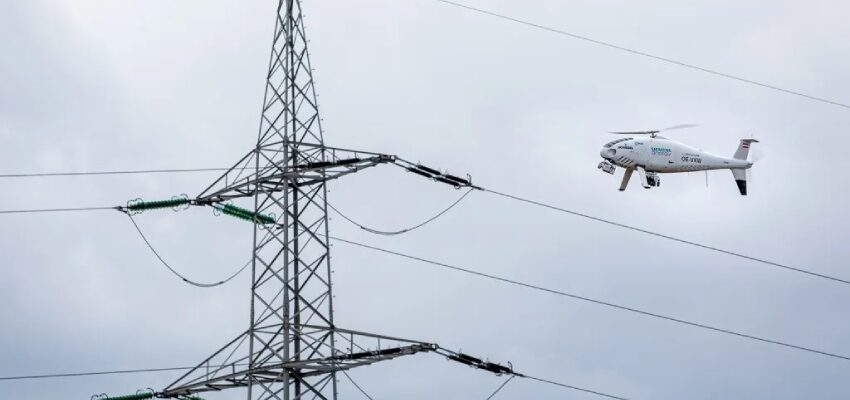From a bird’s-eye view: multi-sensor system and AI ensure secure power supply
Germany: The German grid operators Schleswig Holstein Netz AG and Bayernwerk Netz GmbH have commissioned Siemens Energy to inspect almost 4,000 km of high-voltage overhead lines.

Image source: Siemens Energy
Germany: The German grid operators Schleswig Holstein Netz AG and Bayernwerk Netz GmbH have commissioned Siemens Energy to inspect almost 4,000 km of high-voltage overhead lines.
The inspection will be conducted by a helicopter equipped with a high-tech multi-sensor system using the “SIEAERO” service concept. Developed by Siemens Energy, the system collects all the necessary data during the flight, which can later be evaluated with the help of artificial intelligence and analysed by other software tools. In the near future, this kind of holistic inspection of overhead power lines can also be performed with large drones.
As soon as the respective legal situation permits, the inspection of power lines could be carried out using drones instead of helicopters. It is more environmentally friendly and quieter than a helicopter, and critical locations could be approached in a more targeted manner.
For the inspection, Siemens Energy attaches SIEAERO’s multi-sensor system to the underside of a helicopter. Equipped with 19 cameras and state-of-the-art 3D laser scanning sensors, it captures all relevant inspection data in a single flight over the power line, resulting in up to 12,000 images and detailed 3D data per kilometre of power line. The SIEAERO’s software, which uses artificial intelligence, can evaluate the images in just a few hours, whereas a human would need a few days. The artificial intelligence was previously trained with over two million images of European and North American grids to automatically detect faults in the images. This allows potential risks like trees growing too close to the line to be detected earlier. During the flights, the surface temperature of the individual components is also measured, among other things. The digital data obtained provides a precise and detailed overview of the condition of the operating equipment, and it can be combined with existing data from the grid for other evaluations.
“The use of artificial intelligence is an important advance in the inspection of power lines. The high data quality makes us more precise and more cost-efficient, and it also allows us to conduct the inspection more safely. What’s more, with conventional measurement and inspection techniques, the lines would have to be flown over several times to get the same results. Each flight saved over the distance of 4,000 km saves 74 T of CO2 emissions. This is another way that we are making an important contribution to the environment, while supporting our customers to maximize the reliability of the transmission grids,” says Milena Ramos Subires, Vice President Transmission Service at Siemens Energy.
Every kilometre of line flown generates 300 GB of data. The system uses this data to create a digital twin, a highly accurate image of the network infrastructure being inspected, including poles, lines, terrain, and vegetation. With the digital twin, network operators can simulate extreme events like a tree falling on a line and causing it to fail and take the appropriate preventive measures. To guarantee a continuous power supply during the energy transition, the power grids need to be expanded. With comprehensive 3D models of the grid, the necessary expansion and modification measures can be planned and implemented more quickly.
In the future, drones could once again significantly simplify and improve the inspection of power lines. Using a drone has a number of advantages: It is more environmentally friendly and quieter than a helicopter, and critical locations could be approached in a more targeted manner. Currently, however, most countries still prohibit the use of unmanned aerial vehicles beyond the visual range. As soon as the legal situation permits in these countries, the company plans to offer SIEAERO also as a drone service.
Source: Siemens Energy
#AI#Germany#inspection#multi-sensor system#power supply network#Siemens Energy




